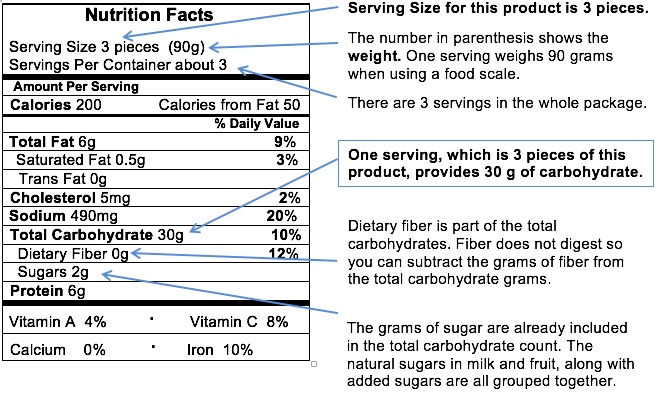Nutrition Labels - How to Read Them and Spot Hidden Sugars
When reading nutrition labels if you are in P2 you want to count all the carbs. TOTAL carbs.
To count carbohydrates, look at three things:
- Serving Size
- Number of Servings Per Container
- Grams of Total Carbohydrate per serving
The total carbohydrate tells how many grams of carbohydrate are in one serving. Be careful when reading the label. There can be more than one serving in the package, so if you eat more than one serving, you will need to multiply the grams of carbohydrate accordingly.
Now let’s practice using a sample food label:

-
What if you eat more, or less than, one serving? Let’s practice with this example label.
- The serving size listed is 3 pieces (or 90 grams if you are weighing the product).
- The grams of total carbohydrate per serving is 30 grams.
- If you eat 6 pieces, that is two servings. You would be getting 60 grams of total carbohydrate (1 serving = 30 grams of total carbohydrate, 2 servings = 60 grams of total carbohydrate).
- Or, if you only eat one piece, then you would only get 10 grams of carbohydrate. (If 3 pieces equals 30 grams of carbohydrate, then each piece must be 10 grams of carbohydrate.)
Remember, when you are learning to count carbohydrates, measure the exact serving size to help train your eye to see what portion sizes look like. When, for example, the serving size is 1 cup, then measure out 1 cup. Measuring foods at home can also make you feel more comfortable with estimating portion sizes in restaurants.
In P3 you count NET carbs
Nutrition Facts labels list a breakdown of the total carbohydrate from dietary fiber, sugars and sugar alcohols. This can be confusing.
On Nutrition Facts food labels, the grams of dietary fiber are already included in the total carbohydrate count, but because fiber is a type of carbohydrate that your body can’t digest, the fiber does not increase your blood sugar levels. You may subtract the grams of fiber from the total carbohydrate. View this example Nutrition Facts label showing fiber.
on a nutrition food label, subtract the fiber from the total carbohydrate amount.
When you read food labels, the grams of sugar are already included in the total carbohydrate amount, so you do not need to count this sugar amount separately. The grams of sugar listed include both natural sugars, from fruit or milk, and added sugars.
on a nutrition food label, the total carbohydrate includes the sugar.
Some Nutrition Facts labels may also list sugar alcohols under total carbohydrate. Sugar alcohols may be found in products that are labeled “sugar-free” or “no sugar added.” But don’t be fooled – sugar alcohols are still a form of carbohydrate, and they still affect your blood sugar levels, if not as dramatically. Usually about half of the sugar alcohol is counted as carbohydrate. Learn more about counting sugar alcohols.
when counting carbohydrates, include half of the sugar from the sugar alcohol.
Added sugar is hiding in 74% of packaged foods
We tend to think that added sugar is mainly found in desserts like cookies and cakes, but it's also found in many savory foods, such as bread and pasta sauce. And some foods promoted as "natural" or "healthy" are laden with added sugars, compounding the confusion. In fact, manufacturers add sugar to 74% of packaged foods sold in supermarkets.1 So, even if you skip dessert, you may still be consuming more added sugar than is recommended.
How do I know if I'm eating added sugar?
Added sugar is hiding in foods that many of us consider healthy, like yogurt and energy bars. It is also added to savory foods, such as ketchup, breads, salad dressing and pasta sauce.The U.S. Food and Drug Administration (FDA) requires food producers to list all ingredients in their foods. But added sugar comes in many forms – which is why it's so hard to find on the ingredients label.
There are at least 61 different names for sugar listed on food labels. These include common names, such as sucrose and high-fructose corn syrup, as well as barley malt, dextrose, maltose and rice syrup, among others.
While product labels list total sugar content, manufacturers are not required to say whether that total includes added sugar, which makes it difficult to know how much of the total comes from added sugar and how much is naturally occurring in ingredients such as fruit or milk. That makes it very difficult to account for how much added sugar we're consuming
Anything listed in the ingredients that ends in "ose" is some form of sugar.
0 comments